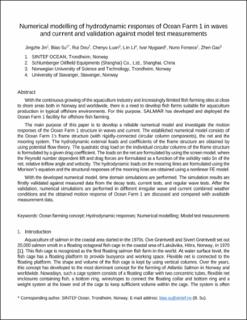| dc.contributor.author | Jin, Jingzhe | |
| dc.contributor.author | Su, Biao | |
| dc.contributor.author | Dou, Rui | |
| dc.contributor.author | Luan, Chenyu | |
| dc.contributor.author | Li, Lin | |
| dc.contributor.author | Nygaard, Ivar | |
| dc.contributor.author | Fonseca, Nuno | |
| dc.contributor.author | Gao, Zhen | |
| dc.date.accessioned | 2022-06-17T13:06:17Z | |
| dc.date.available | 2022-06-17T13:06:17Z | |
| dc.date.created | 2021-08-03T10:21:44Z | |
| dc.date.issued | 2021 | |
| dc.identifier.citation | Marine Structures. 2021, 78, 1-28 | en_US |
| dc.identifier.issn | 0951-8339 | |
| dc.identifier.uri | https://hdl.handle.net/11250/2999348 | |
| dc.description.abstract | With the continuous growing of the aquaculture industry and increasingly limited fish farming sites at close to shore areas both in Norway and worldwide, there is a need to develop fish farms suitable for aquaculture production in typical offshore environments. For this purpose, SALMAR has developed and deployed the Ocean Farm 1 facility for offshore fish farming. The main purpose of this paper is to develop a reliable numerical model and investigate the motion responses of the Ocean Farm 1 structure in waves and current. The established numerical model consists of the Ocean Farm 1's frame structure (with rigidly-connected circular column components), the net and the mooring system. The hydrodynamic external loads and coefficients of the frame structure are obtained by using potential flow theory. The quadratic drag load on the individual circular columns of the frame structure is formulated by a given drag coefficient. The loads on the net are formulated by using the screen model, where the Reynold number dependent lift and drag forces are formulated as a function of the solidity ratio Sn of the net, relative inflow angle and velocity. The hydrodynamic loads on the mooring lines are formulated using the Morison's equation and the structural responses of the mooring lines are obtained using a nonlinear FE model. With the developed numerical model, time domain simulations are performed. The simulation results are firstly validated against measured data from the decay tests, current tests, and regular wave tests. After the validation, numerical simulations are performed in different irregular wave and current combined weather conditions and the obtained motion response of Ocean Farm 1 are discussed and compared with available measurement data. | en_US |
| dc.language.iso | eng | en_US |
| dc.publisher | Elsevier | en_US |
| dc.rights | Attribution-NonCommercial-NoDerivatives 4.0 Internasjonal | * |
| dc.rights.uri | http://creativecommons.org/licenses/by-nc-nd/4.0/deed.no | * |
| dc.subject | Model test measurements | en_US |
| dc.subject | Numerical modelling | en_US |
| dc.subject | Hydrodynamic responses | en_US |
| dc.subject | Ocean farming concept | en_US |
| dc.title | Numerical modelling of hydrodynamic responses of Ocean Farm 1 in waves and current and validation against model test measurements | en_US |
| dc.type | Peer reviewed | en_US |
| dc.type | Journal article | en_US |
| dc.description.version | acceptedVersion | en_US |
| dc.rights.holder | This is the authors’ accepted and refereed manuscript to the article. This manuscript version is made available under the CC-BY-NC-ND 4.0 license | en_US |
| dc.source.pagenumber | 28 | en_US |
| dc.source.volume | 78 | en_US |
| dc.source.journal | Marine Structures | en_US |
| dc.identifier.doi | 10.1016/j.marstruc.2021.103017 | |
| dc.identifier.cristin | 1923571 | |
| dc.source.articlenumber | 103017 | en_US |
| cristin.ispublished | true | |
| cristin.fulltext | postprint | |
| cristin.qualitycode | 2 | |

